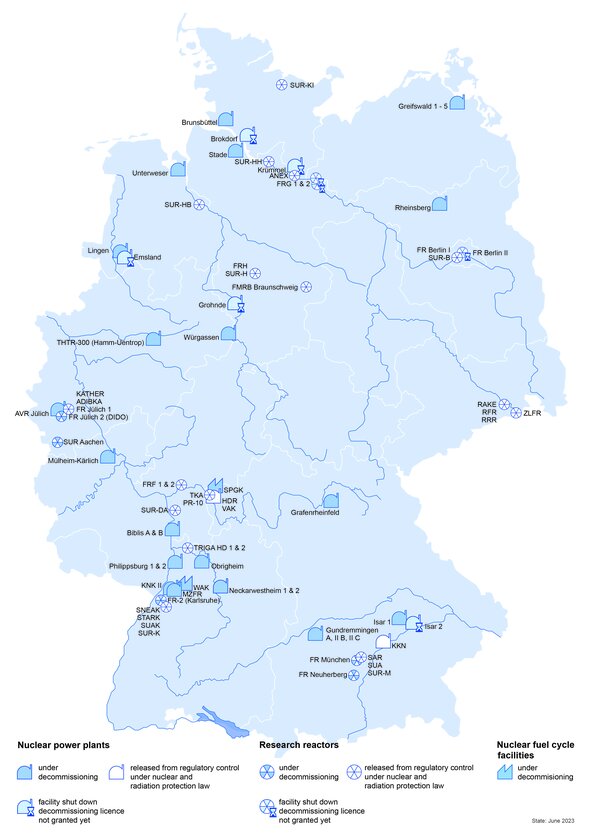Decommissioning projects in Germany:
Overview of the Plants
Every decommissioning project is unique. The choice of decommissioning strategy and project schedule depend to a large extent on the type of facility, operation history and other factors such as financing.
- Power reactors and uranium enrichment and fuel fabrication plants are commercial facilities which belong to the utility companies and businesses operating in this sector. The companies themselves pay for the decommissioning of these installations.
- Research reactors, prototype reactors for electricity generation and prototype fuel cycle facilities are usually located at research centres or universities. The decommissioning of such facilities is for the most part financed using public funds.
- The decommissioning of the Greifswald and Rheinsberg nuclear power plants, both located in the former GDR, is financed from the federal budget.
This map provides an overview of the installations that are being decommissioned in Germany or which have been dismantled completely.
Decommissioning by facility type
Power and prototype reactors
Three nuclear power plants have been fully dismantled:
- Niederaichbach nuclear power plant (KKN)
- Grosswelzheim superheated steam reactor (HDR)
- Kahl experimental nuclear power plant (VAK).
The first two plants are prototype reactors that were not developed further.
Kahl experimental nuclear power plant was the first nuclear power plant built in Germany. After more than 25 years in operation, it was permanently shut down in 1985. Installation parts and buildings were decontaminated and completely dismantled, and the site was released from regulatory control under nuclear and radiation protection law.
Experience has shown that the decommissioning of a power or prototype reactor takes some 10 to 20 years.
Research reactors
Decommissioning of research reactors is based on the same principles as nuclear power plant decommissioning. The decontamination, disassembly and waste conditioning techniques used are very similar. However, the facility size and radioactive inventory are significantly smaller in the case of a research reactor compared to a nuclear power plant.
As research reactors are smaller, technical dismantling often takes less time than is the case with larger power reactors.
Nuclear fuel cycle facilities (excluding interim storage and final repository facilities)
At the Hanau site, several fuel element fabrication plants were shut down, dismantled and released from regulatory control under nuclear and radiation protection law in the 1980s and 1990s. The former Karlsruhe Nuclear Research Center (now Karlsruhe Institute of Technology (KIT) Campus North) ran the Karlsruhe Pilot Reprocessing Plant (WAK) from 1971 to 1990. Dismantling this facility poses particularly complex challenges. In 2009 and 2010, the high-level liquid waste (HLLW) produced during the plant’s operation was conditioned by vitrification in a new purpose-built facility on the WAK site. This Karlsruhe Vitrification Facility (VEK) was later shut down and is part of the WAK decommissioning project.
The operator plans to have fully completed dismantling the facility (including the VEK) by the end of the 2020s.
A key difference to dismantling nuclear power plants is that nuclear fuel cycle facilities are in some cases heavily contaminated with alpha-emitting radionuclides from mechanical and chemical processing of nuclear fuel during operation. Different decontamination and dismantling techniques and a different radiation protection regime for workers are therefore required.
